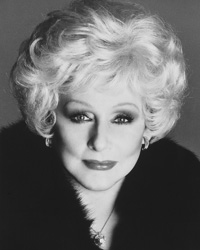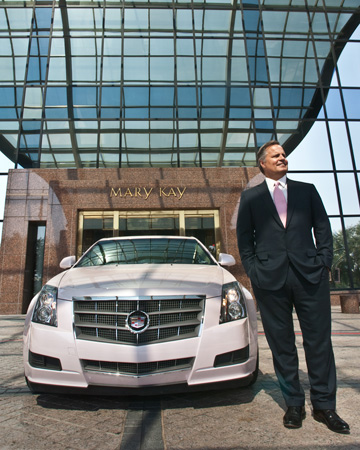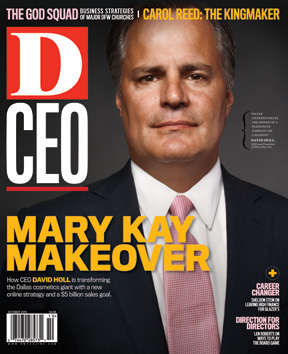
Fierce Brand Loyalty
All told, more than 30,000 Mary Kay consultants flock to North Texas for the company’s convention in Dallas each year, pumping an estimated $72 million into the local economy. The convention seminar productions are elaborate and obviously expensive for the company to host, but the priceless element that makes Mary Kay work is the contagious enthusiasm of the independent sales force.
“Certainly the cosmetic side of the business is a very important factor in Mary Kay’s success, but that’s a given; you have to have that just to stay in the game,” says Shasteen, a 26-year veteran of Mary Kay who served as the chief marketing officer until she retired from the company a few months ago. “What drives us is passion. There’s a deep sense of attachment and belief in the brand, among both the corporate employees and the independent sales force. … Today so many companies are looking for that, and Mary Kay has had it all along. The leadership team clearly understands that’s what drives the business, and that’s the critical success factor.”
That’s not to say the company is without problems. One of the top hits on Google for a search of “Mary Kay” brings up PinkTruth.com, a collection of blog posts by former consultants who became disenchanted with the company. Some claim the recruiters aren’t clear about the steep hidden costs of starting one’s own Mary Kay business, and others dismiss the cosmetics giant as an unsustainable pyramid scheme. In a model with more than half a million independent reps in the United States, there’s bound to be the occasional blowback. But Holl doesn’t let it faze him.
“I think every company nowadays has to be aware of all the different ways your message gets out there and the way it’s perceived, and blogs are certainly one of them. You’ve got to have thick skin,” Holl says. “But the fact is, we’ve got 2 million people that are active in our business and a lot of people [who] are now inactive. We do our own exit interviews; by far the vast majority have a great experience within Mary Kay and stay customers. There’s always going to be some negativity out there, and we just have to focus on what we’re doing right.”
One thing the company is “doing right” is expanding into previously untapped markets.
Holl says when he joined Mary Kay as vice president of finance in 1993, revenue was just under $1 billion and the company had a U.S.-centric business model. Three years later, Mary Kay expanded into China. Two years after that, the Chinese government shut down direct-selling operations. Instead of abandoning the market, Mary Kay kept employees in China on the payroll and focused on developing leadership. The company managed to circumvent the direct-selling ban by building “beauty centers” around the country where beauty consultants could meet with clients. There are now nearly 100 beauty centers in China, and China has become Mary Kay’s second-largest market. Its fastest-growing market, on a percentage basis, is Brazil.
The company opened operations in India about three years ago, but the logistics of navigating the country’s infrastructure have been prohibitive in terms of reaching clients and providing product delivery. Holl says his team has also identified Vietnam, Lithuania, and Peru as potential markets for Mary Kay, but the company is considering whether it would be more beneficial to expand into these new markets or to increase the resources available in India, where Holl says Mary Kay “hasn’t even begun to tap the potential.”
In America, the executive leadership team is busy bringing Mary Kay into the 21st century by changing the way its sales force communicates with customers. On its website, Mary Kay connects new customers to beauty consultants, who in turn have the option of mailing products directly to their customers instead of depending solely on the in-person delivery method of the past. Mary Kay is also all over Facebook, with close to 200,000 fans; the Facebook site mirrors the corporate website, with interactive makeover features, instructive videos, and product updates.
The foray into the online marketplace is a drastic change. But Holl is quick to point out that the power still lies in the hands of the independent beauty consultant. He says Mary Kay chose to tread lightly when it came to shipping directly to the end user because it didn’t want to give the impression that it was taking steps toward making beauty consultants obsolete. The opposite is true: Holl says the company is focusing on increasing the number of consultants and increasing the amount of products those consultants sell.
“We don’t come close to capturing the customers’ beauty purchase,” Holl says. “We’re less than 20 percent of what they spend on products that we sell that they could purchase through us.”
Holl declined to provide specifics—regarding both the number of consultants the company aims to add and increases in per-consultant sales. But he is counting on the initiatives, along with continuing expansion into huge markets like China and India, to drive Mary Kay’s growth and help it hit that $5 billion annual sales goal in 2013.

Honoring the Past
Although the company may be getting a bit of a makeover, one thing that won’t be changing is the enduring presence of its late founder.
In his office on the 13th floor of Mary Kay headquarters, just down the hall from where Ash’s office sits exactly as she left it, Holl recalls a mistake from his early days as company president. Ash had died two years before, and her photograph was deleted from the corporate newsletter. Someone wrote and asked why the photo was removed; Holl says he immediately realized that the letter writer was right. So instead of discarding old photos of Ash, Holl and his team set about replacing those images with lesser-known photos of the much-loved entrepreneur. The sales team wasn’t ready to let her go.
At the company’s 600,000-square-foot corporate headquarters off the tollway in Addison, huge portraits of the company’s founder, always perfectly coiffed and with a full face of makeup, dominate the lobby’s walls.
There’s a large museum on the ground floor, filled with memorabilia Ash collected throughout her life. Today, nearly 10 years after her death, Mary Kay enthusiasts still travel from all over to get a glimpse of Ash’s signature pink office, where drawers in the adjacent bathroom still hold her personal makeup. When company employees reach their 10th anniversary on the job, part of their reward always includes time in Ash’s office.
“Obviously we can’t replicate [personal time with Ash], but what we can do—they come into Mary Kay’s office and sit down, and Mary Kay’s ex-assistant Jennifer Cook, who runs the museum, or somebody else who worked directly for her, will come in and talk about what’s in her office,” Holl says. “With a company like ours, the fact that 50 percent of our [corporate] employees have been here longer than 10 years … speaks to the benefits, speaks to the environment that they’re working in, and it also means that there are people who have been here a long time and are not shy about coming up to me” and sharing their opinions about the company.
Although he’s been the leader of the company for much of the last decade, David Holl has no intention of becoming the face of Mary Kay Inc. “There is only one Mary Kay Ash,” he says.

The Legendary Mary Kay Ash
Mary Kay Ash is one of Dallas’ best-loved success stories. She married her first husband, Ben Rogers, at 17. They had three children but the marriage didn’t last. As a single mother with a family to support, Ash began working in direct sales, and did so for 25 years.At 45, Ash began drafting a book for women, outlining how to navigate the challenges of business. Writing the book inspired Ash to become an entrepreneur, and the idea for what was originally called “Beauty by Mary Kay” was born. One month before she was set to open a 500-square-foot storefront in Dallas, Ash’s then-husband died of a heart attack. On Sept. 13, 1963, she opened the business anyway, with $5,000 and the help of her 20-year-old son, Richard Rogers. By year’s end, the company made a small profit. One year later, wholesale revenue approached $200,000; by the end of its second fiscal year, the company was raking in $800,000.
Last year, 46 years after Ash founded Mary Kay, wholesale revenue for the privately held company hit $2.5 billion.
David Lei, Ph.D., assistant professor of business strategy and entrepreneurship at Southern Methodist University’s Cox School of Business, says Ash, who died on Thanksgiving Day in 2001, is still an iconic role model for budding business leaders.
“There is little doubt that she remains an inspiration to millions of entrepreneurs, in much the same way as Ebby Halliday and others who pulled themselves up in the wake of extremely difficult times, different expectations regarding gender roles, and certainly the roller coaster rides of so many business cycles,” Lei says. “Her sheer grit, perseverance, vision, and exceptional interpersonal skills vaunted her into the ranks of some of America’s greatest business legends.”

CEO Snapshot
David Holl President and CEO, Mary Kay Inc.PERSONAL: Born in October 1960 in Decatur, Ill. Married to Suzanne for 23 years. They have three daughters: Rachel, 14; Sara, 17; and
Brittany, 20.
EDUCATION: B.S. in finance from Clemson University, M.B.A. from the University of South Carolina’s Moore School of Business. Earned the business school’s distinguished alumnus award in 2008.
CAREER: Before joining Mary Kay, Holl was a financial analyst for Union Texas Petroleum in Houston, then became vice president at Citibank in New York. He began working at Mary Kay in June 1993 as vice president of finance, and was named chief financial officer and treasurer in 1996. Holl became president and chief operating officer in October 2001, and was promoted to CEO in April 2006. He also serves on the company’s board.
GIVING BACK: Holl serves on the board of the YWCA of Metropolitan Dallas; he’s also a member of the CEO Council of the World Federation of Direct Selling Associations, The Nature Conservancy, the Personal Care Products Council, and Southwestern Medical Foundation.






